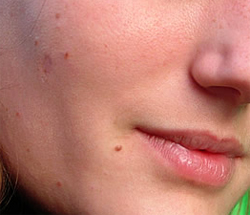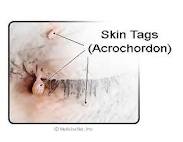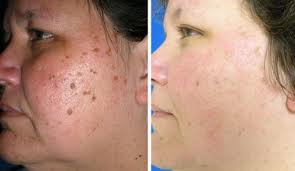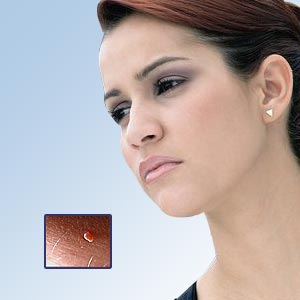SKIN TAGS HOW TO REMOVE NATURAL
?-WHAT IS A SKIN TAG?
Skin tags are common, acquired, benign skin growths that look like a small piece of soft, hanging skin. Skin tags are harmless growths. Some individuals may be more prone to tags (greater than 50-100 tags) either through increased weight, part combined with heredity, or other unknown causes. Males and females are equally prone to developing skin tags. Obesity and being moderately overweight (even temporary increases) dramatically increase the chances of having skin tags. Normal weight individuals with larger breasts are also more prone to skin tags under their breasts. Some small tags spontaneously rub or fall off painlessly and the person may not even know they had a skin tag. Most tags do not fall off on their own and stay around once formed. The medical name for skin tag is acrochordon.

Skin tag are bits of skin- or flesh-colored tissue that project from the surrounding skin from a small, narrow stalk. Some people call these growths "skin tabs" or barnacles. Skin tags typically occur in characteristic locations including the base of the neck, underarms, eyelids, groin folds, and under the breasts (especially where underwire bras rub directly beneath the breasts). Although skin tags may vary somewhat in appearance, they are usually smooth or slightly wrinkled and irregular, flesh-colored or slightly more brown, and hang from the skin by a small stalk. Early or beginning skin tags may be as small as a flattened pinhead-sized bump around the neck. While most tags typically are small (2-5 mm in diameter) at approximately one-third to one-half the size of a pinky fingernail, some skin tags may become as large as a big grape (1 cm in diameter) or a fig (5 cm in diameter).
WHAT IS DIFFERENCE BETWEEN SKIN TAGS AND MOLES?

Skin tags and moles are both skin growths, but skin tags are always benign and moles sometimes precede the development of melanoma. Generally, these skin growths are not treated unless there is a pressing reason to do so, such as aesthetic concerns or worries that a growth has become malignant in nature. Perhaps the key visible difference is that skin tags tend to protrude, while moles are flatter, with a raised surface area.
In the case of skin tags, the growth consists of a benign tumor, usually close to the patient's natural skin color, developing in the form of a flap. Skin tags can appear anywhere in the body, alone or in clusters. Moles are patches of darker skin that typically become rough and raised over time, sometimes also developing unusually long hair. Some moles are congenital, while others appear later in life, in contrast with skin tags, which always develop as people grow older.

Skin tags how to remove? Skin tags and moles are commonly causes for distress because they can look unsightly. Both can be removed in an office procedure by a dermatologist, with cryosurgery being a very common approach to removing unwanted growths like skin tags and moles. In this procedure, a freezing probe is applied to the growth, causing the cells to explode and die. Within a few days, they will slough off, leaving clean skin behind.
People typically ask " skin tags how to remove natural ?" if the skin tags are attracting unwanted attention or causing problems by catching on clothing. In the case of moles, a doctor may recommend removal and biopsy if a moles changes color, texture, or shape in a very short period of time. These can be signs of a malignancy. The doctor will completely remove the mole in the interests of taking the margins of the growth off at the same time a biopsy sample is collected; if the growth does turn out to be malignant, the doctor has already taken the first step in treatment.
Sometimes, skin tags and moles can look ambiguous, especially if a person hasn't noticed a growth before. A dermatologist can inspect the site to determine what kind of skin growth is involved and make treatment recommendations to address the issue. A wait and see approach may be recommended to see if the growth changes in character before aggressive treatments are pursued. People with a history of skin tags and moles should also have it noted in their charts so new doctors know the growths have been documented and discussed.
SKIN TAGS HOW TO REMOVE AT HOME?
If you’re looking for the best way to remove skin tags yourself, then I’m happy you’ve found this website and I strongly suggest you keep reading…
Because this is my uncensored skin tag removal story. The ups, the downs, what things didn’t work and finally the one thing that did help me reach my personal goal of getting rid of skin tags for good.
I remember when for the first time I saw a skin tag on my neck. I thought, what in the world is that thing! I was a little concerned not only because is was quite ugly, but I thought it may be a health problem.
Then I went to visit my parents and noticed something I didn’t notice before. Both of my parents have the same skin tags hanging things on them. Okay, so I felt a little better. But I still wanted this ugly thing gone from my neck.
Then guess what happened. I found another skin tag! Okay, I didn’t want to have these thing showing up all over the place. So I took action to figure out how to get rid of them.

I decided to just cut one off. Not the best idea I ever had I have to admit. Oh my what a mistake. Did it ever hurt. I thought it would never stop bleeding. After that mess, I decided to do some research on removing skin tags the right way.
I found all sorts of crazy stuff. But, one little oil bottle caught my attention. So I bought it. And used the methods on how to remove a skin tag. And it worked like a charm. I have to say I didn’t like that you have to apply the oil three times a day. But it worked great so it’s no big deal.
I hope you find my story useful and encouraging that you don’t have to live skin tags any longer. Click here to learn the best removal of skin tags yourself just like I do.
3 WORST SKIN TAGS HOME REMOVAL REMEDIES
Want to remove skin tags yourself? Before you do, let’s take a look at the worst methods floating around the internet to remove skin tags at home.
I’ve researched many ways to get rid of skin tags, warts, and moles. These methods I’m listing are about the worst I’ve seen.
It’s not a skin tag in the first place. Okay, before you go off and try a method of getting rid of skin tags, you need to be sure you have one. Here’s clear picture of one:
Now, if it doesn’t look like this, it may be a wart or a mole. Skin tag removal methods are different than mole removal and wart removal remedies. So, one of the worst ways I’ve seen to get rid of skin tags is using a mole removal method. Moles have a different solution.
There are different removal of skin tag method depending on where the tag is located. So, another terrible method out there is using a way to get rid of skin tags on the eye lid that should never be used. You need to be very careful if your tag is on your eyelid. Be sure to use the right method!
Using nail clippers on large skin tags is very dangerous. You can cause infection, serious bleeding, and a lot of pain. The removal of skin tags at home on large tags needs to be done with a specific method or you’ll be very sorry to tried to remove them yourself.
Learning how to remove skin tags yourself is easy. But you need to be totally sure you are using the right methods or you can cause more harm than good.
THE WRONG SKIN TAGS REMOVAL
To remove skin tags yourself, you need to have the right home remedy. The wrong ones can cause infection and permanent scarring. But first, do you know how you got skin tags in the first place? And did you know that they can continue to grow bigger?
There are not skin tags remover products at your local store. Some people try to use wart remover for skin tags but jus tend up wasting their money.
The good thing about skin tags is they are harmless. The only thing they cause is pain if they get caught in your clothes. And they are not very pleasant to look at so people get concerned about their appearance. That’s most likely why you are looking for a skin tag remover.
So, what is a skin tag you may be thinking? These are simply little groups of skin. They hang off your skin and look king of oval in shape. They’re soft and don’t hurt unless you pull at them. If it doesn’t look and feel like this, then you should see your doctor.
Maybe you are seeing a number of these things show up. Is there a way to keep them from appearing after doing a skin tag removal method? The short answer is yes.
These skin lesions tend to show up where your skin rubs together or where clothes rubs the skin. So, the common areas are eye lids, arm pits, around the neck because of shirt collars, and in the groin area. They do on occasion show up where there is no skin friction like on the forehead.
Is there a natural skin tag removal method to use at home? Yes, there sure is. Click here now to see the skin tag remover ebook that taught me how to remove skin tags yourself.
REMOVE SKIN TAGS YOURSELF AT HOME -METHODS REVIEWED
Do you want to remove skin tags yourself? Well, you certainly can. Let’s take a look at some of the methods out there that claim to be a way of removing a skin tag.
When you use the right skin tags home remedies method, you can be sure you will no longer have to live with these ugly things. You won’t be embarrassed or worried about how you look because of these skin lesions any longer.
Many people who have them in areas in plain sight like on their face or neck feel quite paranoid about them. Luckily with a few simple skin tag removal at home methods that also remove warts and moles, you will quickly have beautiful looking skin.
Regardless of the location of your skin tags, there is a way to remove a skin tag. On the face, neck, groin, armpits, back, wherever, you can get rid of them for good.
So, what is the safest and most effective way to remove skin tags naturally?
The most common skin tag home removal method is to simply cut them off. I did this once before finding the method I know use. Oh did it ever bleed and hurt! I will never cut them off again. And besides, method of a removing skin tag can lead to infection.
Using unproven methods like clippers can lead to scarring. Do you really want to end up with a scar because you didn’t use the right removal skin tags method? I’m sure you don’t.
You really need to be careful with the home removal skin tags remedies. Be sure to only use a proven method like I use to remove skin tags yourself.
WHAT IS IT SKIN TAGS? A skin mole is a spot on the skin that is usually round or oval in shape. The skin mole can be small or large, and it may range in color from pink, brown, red, or black. The single skin mole is referred to in medical terms as a nevus. When one is discussing moles in the plural form, they are called nevi. Virtually everyone has at least a few moles. Statistically one will find between 10-50 moles on the body. The skin mole can occur on any part of the body.
We are all born with all the moles we will ever have. Many of them are not visible at birth but will darken as one ages. A skin mole is called by a collection of cells named melanocytes. These are present throughout the skin and are a part of skin pigmentation. When melanocytes occur in cluster formations they result in the eventual appearance of a skin mole.
A skin mole may be flat or it may be raised. Some will sprout a few hairs, which is normal. Unsightly moles can be removed. Usually, since the skin mole is so common, people do not have one removed unless the mole is quite large. A skin mole can be removed using several different methods, and depending on the size of the mole, may result in some scarring.

Common methods of removing a skin mole are surgical, either standard or laser, and through depositing acid on the mole to burn away the tissue. Surgical removal of a skin mole may be conducted in three ways.
The surgeon can remove the visible layers of the mole with a scalpel, and then dig out the remaining melanocytes with the scalpel. He or she may also use a scalpel to take off the top layer, and then use an electric needle to destroy the tissue beneath the surface. A procedure called cryosurgery applies liquid nitrogen to the mole, which essentially freezes off the mole. Laser surgery uses directed laser pulses to destroy the skin mole. Cryosurgery and Laser surgery tend to result in minimal scarring, but the size of the mole influences eventual scarring from any of the procedures.
Over the counter herbal mixtures and acids may also be used to remove a skin mole. These may result in more scarring, and some of the claims of herbal preparations are dubious. It is also important to be certain that the mole you are removing is a regular mole and not skin cancer, since these preparations will probably not remove all layers of the mole.
All moles have the potential to become skin cancer, and one should be vigilant in watching moles for signs of melanoma, which grows from melanocytes cells. Sudden changes in a mole, bleeding, rapid growth, or irregular size may all signify development of basal cell, squamous cell, or malignant melanoma. Changes in a skin mole or multiple moles warrant immediate attention by a physician.
Though basal cell is not likely to spread to other part of the body, the moles can become exceptionally large, causing a great deal of scarring upon removal. Both squamous cell and melanoma can metastasize quickly, spreading cancerous cells to other parts of the body. Thus even the most innocent skin moles should be watched for changes. If you have an abundance of skin moles this is called dysplastic nevi. This is a genetic condition that predisposes one for greater risk of developing skin cancer. Avoiding the sun and using sunscreen when you are outside is essential. You might want to take a picture or pictures of the moles every six months to year, in the same location and from the same angle. That way you can evaluate the pictures to see if your moles appear to be changing. Otherwise, all should watch for signs of irregularity and seek early treatment if a mole appears to have changed.
Moles are growths on the skin. They happen when cells in the skin, called melanocytes, grow in a cluster with tissue surrounding them. Moles are very common. Most people have between 10 and 40 moles. A person may develop new moles from time to time, usually until about age 40.
Moles are usually pink, tan or brown. They can be flat or raised. They are usually round or oval and no larger than a pencil eraser.
About one out of every ten people has at least one unusual (or atypical) mole that looks different from an ordinary mole. The medical term for these unusual moles is dysplastic nevi. They may be more likely than ordinary moles to develop into melanoma, a type of skin cancer. Because of this, you should have a healthcare professional check your moles if they look unusual, grow larger, change in color or outline, or in any other way.
NIH: National Cancer Institute
